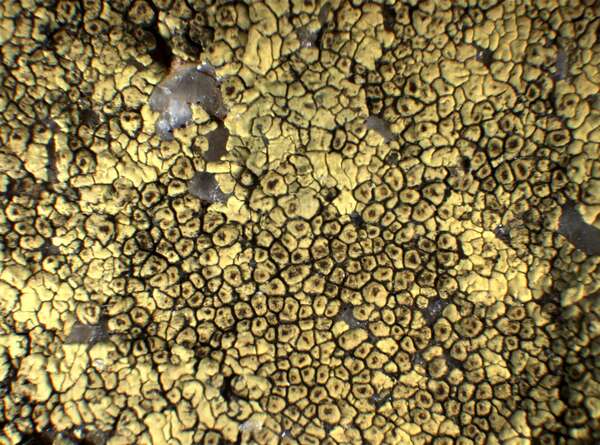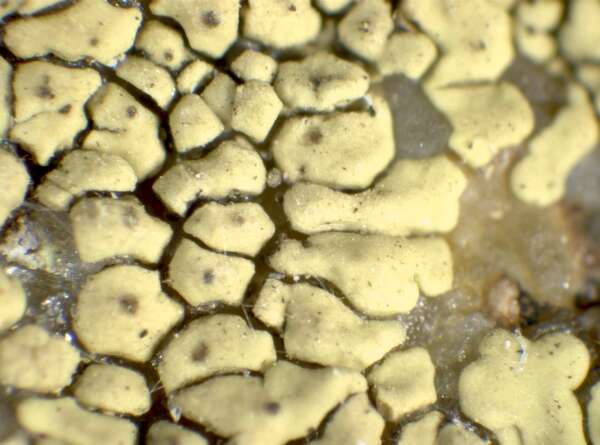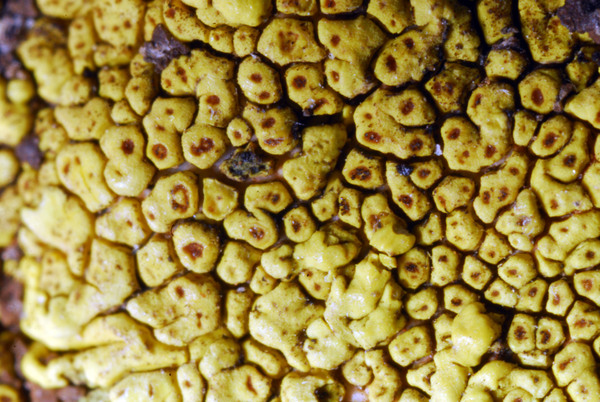Acarospora hilaris (Nyl.) Hue
Nouv. Arch. Mus. Hist. Nat., sér. 5 1: 113, 1909. Basionym: Lecanora hilaris Dufour ex Nyl. - Not. Sallsk. Fauna Fl. Fenn. Förh., 5: 177, 1861.
Synonyms: Placodium chlorophanum var. hilare (Dufour) Boistel
Distribution: C - Tosc (Tretiach 1993), Sar (Tretiach 1993). S - Cal (Puntillo 1996), Si (Nimis & al. 1996b, Grillo & Caniglia 2004).
Description: Thallus crustose-placodioid, episubstratic, bright lemon yellow, slightly glossy, epruinose, forming orbicular to irregular, often confluent rosettes covering wide surfaces. Central parts of thallus of contiguous, angular, flat to slightly convex areoles; marginal lobes radiating, flat or weakly convex, 1-2(-4) x 0.3-0.6(-1) mm. Medulla white; algal layer continuous. Apothecia lecanorine, immersed in the areoles (1-3 per areole), with a punctiform, dark brown disc and a poorly evident thalline margin. Epithecium brownish; hymenium colourless, 85-100 µm high; paraphyses 1.5-2 µm thick at base, the apical cells hardly swollen; hypothecium colourless. Asci 100-200-spored, broadly ellipsoid, the apical dome K/I-. Ascospores 1-celled, hyaline, ellipsoid, 3-6 x c. 2 µm. Photobiont chlorococcoid. Spot tests: cortex and medulla K-, C-, KC-, P-. Chemistry: cortex with rhizocarpic acid, rarely with epanorin.Note: a xeric subtropical species found on vertical, often rain-sheltered faces of hard siliceous rocks, restricted to the driest parts of Mediterranean Italy. Chemically heterogeneous (epanorin or rhizocarpic acid).
Growth form: Crustose placodiomorph
Substrata: rocks
Photobiont: green algae other than Trentepohlia
Reproductive strategy: mainly sexual
In underhangs rarely wetted by rain
Commonnes-rarity: (info)
Alpine belt: absent
Subalpine belt: absent
Oromediterranean belt: absent
Montane belt: absent
Submediterranean belt: absent
Padanian area: absent
Humid submediterranean belt: absent
Humid mediterranean belt: extremely rare
Dry mediterranean belt: very rare

Predictive model
Herbarium samples
Growth form: Crustose placodiomorph
Substrata: rocks
Photobiont: green algae other than Trentepohlia
Reproductive strategy: mainly sexual
In underhangs rarely wetted by rain
Commonnes-rarity: (info)
Alpine belt: absent
Subalpine belt: absent
Oromediterranean belt: absent
Montane belt: absent
Submediterranean belt: absent
Padanian area: absent
Humid submediterranean belt: absent
Humid mediterranean belt: extremely rare
Dry mediterranean belt: very rare

Predictive model
| Herbarium samples |





